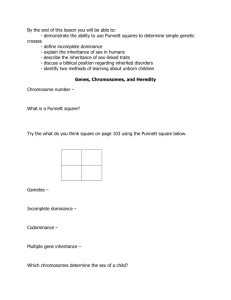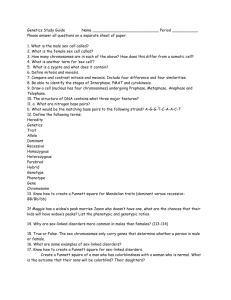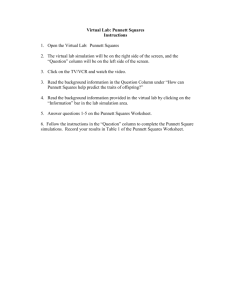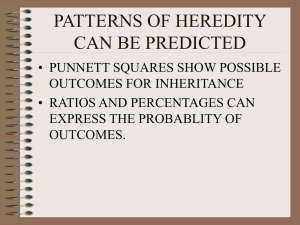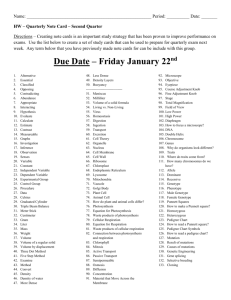ohio graduation tests - Ohio Department of Education
advertisement
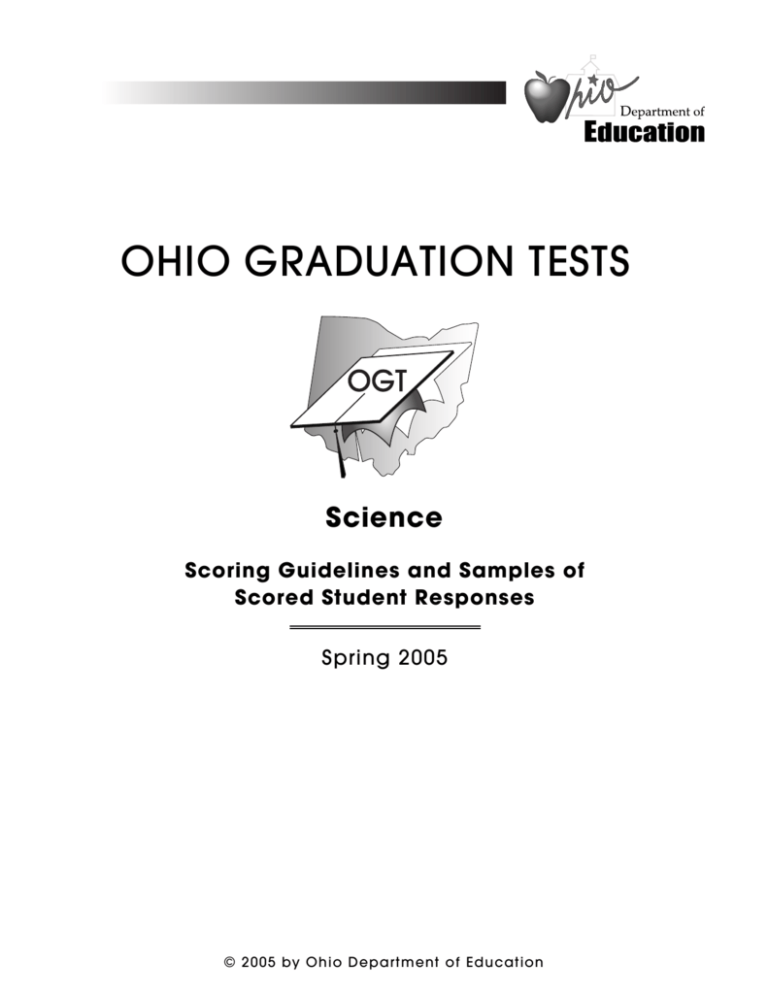
OHIO GRADUATION TESTS Science Scoring Guidelines and Samples of Scored Student Responses Spring 2005 © 2005 by Ohio Department of Education Table of Contents Item 6: Item and Scoring Guidelines .......................... 1 Item 6: Samples of Scored Student Responses ......... 4 Item 12: Item and Scoring Guidelines ...................... 14 Item 12: Samples of Scored Student Responses ..... 19 Item 18: Item and Scoring Guidelines ...................... 36 Item 18: Samples of Scored Student Responses ..... 39 Item 24: Item and Scoring Guidelines ...................... 52 Item 24: Samples of Scored Student Responses ..... 54 Item 36: Item and Scoring Guidelines ...................... 65 Item 36: Samples of Scored Student Responses ..... 68 Item 42: Item and Scoring Guidelines ...................... 84 Item 42: Samples of Scored Student Responses ..... 86 Science Item 6 Spring 2005 Item and Scoring Guidelines 1 Passage Inclined Plane Experiment In doing the following inclined plane experiment in “ideal conditions,” students assume that friction from the air, incline or floor is negligible. A stationary box at the top of a frictionless incline is released and is allowed to slide to the bottom. The figure below illustrates the box in four positions labeled A through D as it is sliding from the incline onto the level floor. As the box moves from the bottom of the incline to the floor, students assume that the box experiences no change in speed, only a change in direction. Item GS0040PSDXC0349S 6. Assume that the experiment will be repeated in less “ideal” conditions where the effects of friction on the motion of the box cannot be ignored. Predict the effect that significant friction would have on the acceleration of the box as it slides down the incline. Explain the cause of the predicted effect. Respond in the space provided in your Answer Document. (2 points) 2 Sample Response for Item 6 (Short Answer): The acceleration would be less. OR The velocity or speed would not increase as quickly. AND This results from friction opposing the force along the direction of motion that the box experiences due to gravity while on the incline. OR The action of friction on the box as it moves down the incline results on a lower net force acting to accelerate the box. Scoring Guidelines for Item 6: Score point Description 2 points The response correctly predicts the effect that friction would have on the acceleration of the box and explains the cause of this effect. 1 point The response correctly predicts the effect that friction would have on the acceleration of the box. OR The response indicates that friction would oppose the force of gravity but does not explain the cause of this effect. 0 points The response demonstrates no understanding of the task. The response may provide incorrect information or be irrelevant to the task. The response may repeat information from the passage or prompt, or state “I don’t know.” 3 Science Item 6 Spring 2005 Samples of Scored Student Responses 4 Score Point: 0 This response states that “Friction would make the box go faster and then slower …” The response does not successfully predict the effect friction has on the box and explain the cause of the effect. 5 Score Point: 0 This response incorrectly predicts the effect when it states that “the box will slide down faster.” The response does not correctly explain the cause of this effect. 6 Score Point: 0 This response incorrectly predicts the effect when it states that “friction would cause the box not to move.” The remainder of this response is irrelevant to the task of explaining the cause of the effect. 7 Score Point: 1 This response successfully predicts the effect by stating that “Friction would slow the box’s times down.” No attempt to explain the cause of this effect is presented. 8 Score Point: 1 In this response, the cause of the predicted effect is explained successfully by stating that the box “still would be held back by friction.” The response provides a clearly inconsistent prediction of the effect by stating that “it would gain speed” and “ultimately slows the box down”. 9 Score Point: 1 This response successfully predicts the effect by stating that “acceleration would decrease.” The term “resistance” alone is not acceptable as an explanation of the cause of the predicted effect. 10 Score Point: 2 This response adequately predicts the effect of friction on the box by stating that, with more friction, “the box won’t accelerate as fast.” By stating that “nothing is holding the object back” on a frictionless surface is acceptable as an explanation of the cause of the predicted effect. 11 Score Point: 2 This is a thorough and successful response. The response correctly predicts the effect and explains the cause with regard to friction (“applying an opposite force”) and the acceleration (“decrease of acceleration”) of the box as it slides down the incline. 12 Score Point: 2 This response correctly predicts that friction will slow the acceleration of the box, and explains opposing forces as the cause. 13 Science Item 12 Spring 2005 Item and Scoring Guidelines 14 Passage Sickle cell Disease Sickle cell disease is a group of inherited disorders in which deoxygenated red blood cells become distorted and take on a shape like a sickle. There are two common alleles for this gene. One causes normally shaped red blood cells and the other allele causes the red blood cells to have a sickle shape. The sickled cells can lodge in the smallest blood vessels and reduce the circulation of blood to tissues. The sickle cell allele is most common in areas where the disease malaria is a significant problem, and among people whose ancestors are from those areas. Evidence shows that having just one sickle cell allele makes a person resistant to malaria. This genetic condition is a recessive trait. When an individual has only one allele for the sickle cell trait, the person is a carrier. The pedigree below represents a family in which some members have the sickle cell allele. 15 Item GS0013LSCXD0236E 12. Draw a Punnett square or comparable diagram for the couple in the first generation of the pedigree. Use B to represent the allele for normal red blood cells and b to represent the allele for sickle cell disease. How do the couple’s actual children compare to the expected results shown in your Punnett square? Respond in the space provided in your Answer Document. (4 points) Sample Response for Item 12 (Extended Response): The accurate Punnett square has two characteristics (2 points). • Genotypes BB and Bb are shown for parents (top row and left column). • Genotypes BB and Bb are in proper squares representing offspring. B b B BB Bb B BB Bb Notes: • The response may not have the last row on the Punnett square complete and it would still be correct. The response could show the cross. • The response does not necessarily have to label the genotypes “male parent” and “female parent” as long as the contents of the chart are correct. The comparison of actual results to the expected results described by the response includes two parts (1 point each). • • A Punnett square that shows half (50%) of the expected offspring being carriers (Bb). OR An accurate interpretation of their Punnett square. AND • • The pedigree shows three out of four of the offspring (75%) being carriers. OR The Punnett square ration gives the chance for each offspring having the allele for sickle-cell. AND 16 • The results of a small population may deviate from the predicted ratios. The predicted ratios would be more observable in larger populations. Example: “The Punnett square only shows half of the children being carriers, but actually three out of four are carriers as read from the pedigree.” Notes: • The response may also interpret the Punnett square and pedigree based on incomplete dominance. In this case, three out of four offspring may exhibit symptoms of the disease due to incomplete dominance. • The response may compare non-carriers instead, i.e., the Punnett square shows half of the offspring without the sickle-cell gene, but only one of four actual offspring lacks the gene. Scoring Guidelines for Item 12: Score point Description 4 points The response shows a correctly drawn Punnett square or a diagram of the cross. The response includes an accurate interpretation of the Punnett square. The comparison is completed by including a statement that the couple’s children, based upon the given pedigree, do not match the numbers expected from the Punnett square. 3 points The response shows a correctly drawn Punnett square or a diagram of the cross. The response interprets the pedigree or makes an accurate comparison between the Punnett square and the pedigree. OR The response shows a single error in the Punnett square but follows through by correctly interpreting the pedigree and makes an accurate comparison between the student’s Punnett square and the pedigree. 2 points The response shows a correctly drawn Punnett square or diagram of the cross. OR The response shows a single error in the Punnett square but follows through by correctly interpreting the Punnett square. OR The response fails to show a Punnett square but provides a correct interpretation and comparison with the results of the pedigree. 17 For example: “The pedigree shows three out of the four children as carriers. In a cross between a male BB parent and a female Bb parent, however, only 50% of the offspring would be expected to carry the gene.” 1 point The response shows a single error in the Punnett square or other diagram of the cross. OR The response gives a correct interpretation of the Punnett square without attempting to draw one. OR The response gives a correct interpretation of the pedigree. 0 points The student response does not meet the criteria to earn one point. The response indicates inadequate or no understanding of the task. It may only repeat information from the passage or prompt or provide incorrect or irrelevant information. The student may have written on a different topic or written, “I don’t know.” 18 Science Item 12 Spring 2005 Samples of Scored Student Responses 19 Score Point: 0 The response does not meet the criteria to earn one point. The response indicates no understanding. 20 Score Point: 0 The response does not meet the criteria to earn one point. The information is too vague to indicate any understanding. 21 Score Point: 0 The response does not meet the criteria to earn one point. It suggests that a carrier can not give a child a disease, thus indicating no understanding of how alleles are passed on to the next generation. 22 Score Point: 1 The response makes a single error in the Punnett square. The response receives one point for correctly setting up and crossing an incorrect genotype. 23 Score Point: 1 The response gives a correct interpretation of the Punnett square without attempting to draw one “There is a 50% chance it will carry the sickle cell allele”. 24 Score Point: 1 The response gives a correct interpretation of the pedigree. 25 Score Point: 2 The response includes a correct Punnett square. The response does not accurately compare the Punnett square results to the actual children represented by the pedigree. 26 Score Point: 2 The response contains a correct Punnett square, for a score of “2”. The discussion lacks clarity and does not receive credit. 27 Score Point: 2 The response fails to provide a Punnett square but provides a correct interpretation and comparison with the results of the pedigree. 28 Score Point: 3 This response contains a correctly drawn Punnett square but fails to correctly interpret the Punnett square results. The response does make an accurate comparison between the misinterpreted Punnett square and the pedigree. 29 Score Point: 3 The response provides an accurate Punnett square. The response also interprets the Punnett square “it shows 2 healthy and two carriers”. The response fails to make an accurate comparison between the Punnett square and pedigree. 30 Score Point: 3 The response shows a Punnett square drawn correctly. The response makes an accurate comparison between the Punnett square and the pedigree without interpreting the Punnett square. 31 Score Point: 3 The response includes a single error in the Punnett square but follows through by correctly interpreting the Punnett square. The response makes an accurate comparison between the student’s Punnett square and the pedigree. 32 Score Point: 4 The response shows a Punnett square drawn correctly. The given information includes an accurate interpretation of the Punnett square and comparison of the pedigree. 33 Score Point: 4 The response shows a Punnett square drawn correctly. The given information includes an accurate interpretation of the Punnett square and comparison with the pedigree. 34 Score Point: 4 The response shows a Punnett square drawn correctly. It includes an accurate interpretation of the Punnett square and comparison with the pedigree. 35 Science Item 18 Spring 2005 Item and Scoring Guidelines 36 Passage Biomes The following graph shows the ranges of temperature and precipitation for six American biomes, two of which are identified by name. Item GS0022ESBXC0489S 18. Locate biome W and the temperate forest on the graph. Based on the information provided, describe one similarity and one difference between the climates of these two biomes. Respond in the space provided in your Answer Document. (2 points) 37 Sample Response for Item 18 (Short Answer): Similarities • Biome W and the temperate forest have similar annual temperature ranges. • Each environment supports living organisms. • Each has a variety of organisms that survive in the environment. • Other acceptable responses Differences • The temperate forest generally has higher annual precipitation than biome W. • The temperate forest is likely to have greater biodiversity than biome W. • Other acceptable responses. Scoring Guidelines for Item 18: Score point Description 2 points The response correctly describes one similarity and one difference between biome W and the temperate forest. 1 point The student correctly describes one similarity or one difference between biome W and the temperate forest. 0 points The response demonstrates no understanding of the task. The response may provide incorrect information or be irrelevant to the task. The response may repeat information from the passage or prompt, or state “I don’t know.” 38 Science Item 18 Spring 2005 Samples of Scored Student Responses 39 Score Point: 0 This response demonstrates no understanding of the task. The comparison of biome X from the graph to biome W is incorrect. 40 Score Point: 0 In this response, credit is not given for the attempt to answer the portion of the question dealing with similarities because the response includes “X” in the discussion of differences. It is accepted that biome X is being used for both comparisons. 41 Score Point: 0 This response provides numbers which lack detail and are unclear. Effective understanding of the task is not demonstrated. 42 Score Point: 0 This response does not address a similarity between biome W and the temperate forest. The response fails to identify what difference exists between the two biomes in a quantitative manner. There is no indication of which biome receives more or less precipitation. 43 Score Point: 1 This response correctly identifies a similarity that exists for the biomes. There is no attempt to address any difference between the biomes. 44 Score Point: 1 In this response, mean annual temperature is identified as a similarity of the temperate forest and biome W. The discussion of a difference between the biomes is unclear and does not receive credit. 45 Score Point: 1 The phrase “average climate” is not acceptable as a similarity. The response correctly identifies the temperate forest as having greater or more precipitation. 46 Score Point: 1 This response correctly states that biome W has less precipitation than the temperate forest. The assertion that the temperate forest has more land is irrelevant to the task. 47 Score Point: 2 This brief response meets the requirements of the task. It identifies temperature as a similarity and states that the forest receives more rainfall as the difference. 48 Score Point: 2 This response states that biome W has less precipitation than the temperate forest, thereby, identifying an acceptable difference in the biomes. Stating that they have a close temperature range is acceptable for a similarity in the climates. 49 Score Point: 2 This response provides an acceptable similarity and difference that utilizes the graph appropriately. The biomes are effectively compared for this score point. 50 Score Point: 2 This response correctly identifies temperature as a similarity. It also states that the temperate forest has more precipitation which is a difference between the biomes. 51 Science Item 24 Spring 2005 Item and Scoring Guidelines 52 Item GS0000STBXR0793S 24. In 1960, physicist Theodore Maiman constructed the first working laser. This design was improved upon by Bell Telephone Laboratories in 1961. Since then, lasers have been found to have a wide variety of applications. Identify one application of laser technology and explain how this application has impacted society. Respond in the space provided in your Answer Document. (2 points) Sample Response for Item 24 (Short Answer): Acceptable applications of laser technology include: • Use in eye surgery for reattaching retinas or correcting vision problems • Use in invasive surgery for sealing off blood vessels • Use in dermatology for reducing the signs of aging or removing skin cancers • Use in the military for weapons or guidance systems • Use in industry for cutting and welding extremely hard material and for making precise measurements • Use in communications for voice and data transmissions via fiber optic lines • Everyday uses such as CD players, DVD players or retail scanners for entertainment or data storage • Detect earth movement for seismic activity • Other acceptable responses Scoring Guidelines for Item 24: Score point Description 2 points The response identifies one application of laser technology and explains how this application has impacted society. 1 point The response identifies one application of laser technology or explains how this application has impacted society. 0 points The response demonstrates no understanding of the task. The response may provide incorrect information or be irrelevant to the task. The response may repeat information from the passage or prompt or state “I don’t know.” 53 Science Item 24 Spring 2005 Samples of Scored Student Responses 54 Score Point: 0 This response provides irrelevant information in response to the task. The response does not identify one application of laser technology. This response does not explain how this application has impacted society. 55 Score Point: 0 This response does not provide enough specific information to receive credit for either a description of an application or an impact on society. 56 Score Point: 0 This response identifies “the laser beam” as an application of laser technology. This is not a sufficient description of an application. The response does not demonstrate understanding of how laser technology has impacted society, because the attempt to explain a societal impact “using them for a wide variety of things” is too vague. 57 Score Point: 1 This response correctly identifies an application of laser technology (surgery). The explanation demonstrates no understanding of the impact of this technology; it is too vague. 58 Score Point: 1 This response does not identify an appropriate application of laser technology. The response explains a potentially negative impact of such technology if it is improperly used. 59 Score Point: 1 This response correctly identifies an application of laser technology (laser sights). There is no attempt to discuss an impact on society. 60 Score Point: 2 This response identifies measuring earth movement by stating that “scientists can study how far the landmass is moving” as one application of laser technology. The response shows evidence of understanding the impact on society of such application for detecting “earthquakes.” 61 Score Point: 2 This response identifies the laser printer as an application of laser technology. The response explains how the laser printer impacts society by making it “easier to print color … and they make it fast.” 62 Score Point: 2 This response identifies “compact disk players” as an application of laser technology. The response explains how it has impacted society by making “it easier to carry music with you.” 63 Score Point: 2 This response identifies two correct applications (level laser, motion detection laser) of laser technology. Two impacts are correctly explained. Either correct combination of laser technology application and impact is sufficient for a score point of “2.” 64 Science Item 36 Spring 2005 Item and Scoring Guidelines 65 Passage A medical researcher is investigating immune response in patients exposed to a specific pathogen. The graph below shows the concentration of a particular antibody in the bloodstream produced during the process of acquired immunity. One curve shows the primary immune response (after the first exposure to the pathogen), and the other curve shows the secondary immune response (after the second exposure to the pathogen). A vaccination serves as the first exposure to a pathogen and triggers the body’s primary immune response. Some vaccines contain weakened or inactive pathogens. Other vaccines contain highly similar but nonpathogenic forms. Item GS0000SKDXC0412E 36. Describe two benefits of receiving a vaccine, such as the polio vaccine, in protecting the body against disease, and include data from the graph to support each benefit. Respond in the space provided in your Answer Document. (4 points) 66 Sample Response for Item 36 (Extended Response): The vaccination causes the body to produce antibodies for the specific pathogen because you can see the graph increasing up to week two. OR The vaccination causes the body to produce antibodies for the specific pathogen. The primary response takes about fourteen days to reach maximum concentration of antibodies in the bloodstream. After the vaccination, some antibodies are retained in the bloodstream to recognize the harmful form of the pathogen in subsequent exposures; you can see the graph increase rapidly at the beginning of week six, after the second exposure. In the even t of a second exposure, the body is able to mount a rapid and significant defense that destroys the pathogen before any harm is caused. The secondary response requires only a couple of days to produce twice as great a concentration of antibodies as in the primary response. Scoring Guidelines for Item 36: Score point Description 4 points The response describes two benefits of receiving a vaccination and provides supporting data from the graph for each benefit. 3 points The response describes two benefits of receiving a vaccination and provides supporting data from the graph for one of these benefits. 2 points The response describes two benefits of receiving a vaccination but fails to provide appropriate supporting data from the graph. OR The response describes one benefit of receiving a vaccination and provides data from the graph for that benefit. 1 point The response describes one benefit of receiving a vaccination. The response provides unrelated or unclear information. 0 points The response demonstrates no understanding of the task. The response may provide incorrect information or be irrelevant to the task. The response may repeat information from the passage or prompt, or state “I don’t know.” 67 Science Item 36 Spring 2005 Samples of Scored Student Responses 68 Score Point: 0 The response demonstrates no understanding of the task. It fails to explain how a vaccine is helpful to the body. The response is too vague to earn one point. 69 Score Point: 0 The response demonstrates no understanding of the task. The response only repeats information given in the prompt and provides supporting data from the graph without describing the benefits of receiving a vaccination. 70 Score Point: 0 The response demonstrates no understanding of the task. It suggests that the vaccine is killing the pathogen instead of antibodies, which are produced in response to the vaccine. 71 Score Point: 1 The response describes one benefit of receiving a vaccination, “there chances of getting the disease is minute”. 72 Score Point: 1 The response describes one benefit of receiving a vaccination, “your are most likely not going to get that disease”. 73 Score Point: 1 The response describes one benefit of receiving a vaccination, “there will be more antibodies in your bloodstream to fight off an infection or disease”. The last sentence does not accurately identify a second benefit. 74 Score Point: 2 This response describes two benefits of receiving a vaccine “to produce antibodies” and “keep up the immunity”, but does not provide appropriate supporting data from the graph. 75 Score Point: 2 The response describes one benefit of receiving a vaccination, “it helps your concentration of antibody, and helps fight against disease and sickness”. The response provides data from the graph for that benefit, “the data table it shows the concentration of your antibody rising higher after the first, and higher than the first on the second”. The last sentence is only a restatement and does not contribute to or detract from the score. 76 Score Point: 2 The response describes two benefits of receiving a vaccination but fails to provide appropriate supporting data from the graph. The first benefit is “it works as a protector for your body to fight away all the harmful germs which could cause you to get these diseases.” The second benefit is “if you do get the disease it won’t be as strong as it would without the vaccine”. Along with prevention, the response includes a severity benefit. The last statement receives no credit. 77 Score Point: 3 The response describes two benefits of receiving a vaccination. The first benefit is “making it easier to be immune to diseases.” The second benefit is “to receive a second exposure, the concentration antibody would be really high.” The response also provides supporting data from the graph for one of these benefits, “Receiving a vaccine causes the concentration of the antibody to increase”. The response shows how a student can receive credit for providing supporting data before describing a benefit. 78 Score Point: 3 The response describes two benefits of receiving a vaccination, “Vaccines prevent diseases by helping the body locate and destroy pathogens. If the illness comes afterward, the body knows how to destroy it with antibodies”. Supporting data from the graph for one of these benefits is provided “The chart shows that after the second exposure, there are much more antibodies to stop the pathogen”. 79 Score Point: 3 The response describes two benefits of receiving a vaccination. The first benefit is “Receiving a vaccine allows your body to create antibodies without receiving enough pathogen to be harmed.” The second benefit is “Antibodies never go away, so in the future if you come in contact with this virus, you will have already produced the correct antibodies.” Supporting data from the graph for one of these benefits is provided, “As you can see once you are exposed your body produces the correct antibodies”. The response actually gives three benefits, only two of which are able to receive credit. 80 Score Point: 4 The response describes two benefits of receiving a vaccination and provides supporting data from the graph for each benefit. The response shows order is not important when considering what can receive credit. The supporting data for prevention (having a small amount of resistance) and the supporting data for fighting off the disease (having a large amount of antibodies) are both presented before the benefits. 81 Score Point: 4 The response describes two benefits of receiving a vaccination and provides supporting data from the graph for each benefit. The response shows how similar data can support two different benefits. 82 Score Point: 4 The response describes two benefits of receiving a vaccination and provides supporting data from the graph for each benefit. The last sentence indicates that the drop in concentration of antibodies levels out as time passes. 83 Science Item 42 Spring 2005 Item and Scoring Guidelines 84 Item GS0000SIAXC0667S 42. An agricultural scientist wants to determine the effect of fertilizers on corn plant growth. She selects a fertilizer to treat a soil plot where corn seeds have just sprouted. Describe an appropriate control she could use to determine whether the fertilizer affects growth of the corn plants. Explain why it is important to include this control. Respond in the space provided in your Answer Document. (2 points) Sample Response for Item 42 (Short Answer): The response describes an appropriate control for the scientist’s study (e.g., “The scientist should include a similar soil plot containing newly sprouted corn seeds that are not treated with fertilizer.”). AND If the scientist wants to determine whether fertilizer has an effect on growth, she needs to observe how growth takes place in the absence of fertilizer. Otherwise she would not be able to attribute any observations she makes to the use of the fertilizer. Scoring Guidelines for Item 42: Score point Description 2 points The response describes an appropriate control and why it is important to include the control. 1 point The response describes an appropriate control. OR The response successfully explains the need for controls in experimental design. 0 points The response demonstrates no understanding of the task. The response may provide incorrect information or be irrelevant to the task. The response may repeat information from the passage or prompt, or state “I don’t know.” 85 Science Item 42 Spring 2005 Samples of Scored Student Responses 86 Score Point: 0 This response fails to identify an appropriate control and offers no explanation of the importance of using a control. 87 Score Point: 0 This response incorrectly identifies the amount of sunlight as the control for this experiment. 88 Score Point: 0 This response fails to identify a control or an explanation of the use of a control in the experiment. It only proposes keeping a record of plant growth. This response demonstrates no understanding of the task. 89 Score Point: 0 This response fails to identify a control or explain the use of a control for the experiment. This response proposes keeping levels of variables constant. This is irrelevant to the task. 90 Score Point: 1 This response describes an appropriate control. The discussion of the isolation of the portions of the field fails to provide an explanation for why a control is needed for the experiment. 91 Score Point: 1 This response describes using a plot with fertilizer and one without fertilizer. This is good for an appropriate control. There is no discussion of why it is important to use the control. 92 Score Point: 1 This response fails to effectively describe a control for the scientist’s study. However, an acceptable explanation of the need for a control is presented, “Its important to include this control b/c without it, there would be nothing to compare the experimental results to”. 93 Score Point: 2 This response identifies an appropriate control and discusses the importance of the control to be used in a comparative scenario. 94 Score Point: 2 This response identifies an appropriate control and explains why it is important for the study. There is further discussion about testing different amounts of fertilizer that does not add to or detract from the score. 95 Score Point: 2 This response includes an effective control for the study. The explanation of the control is somewhat imprecise, but is acceptable. The response also provides an acceptable explanation of the need for a control in an experimental design. 96

